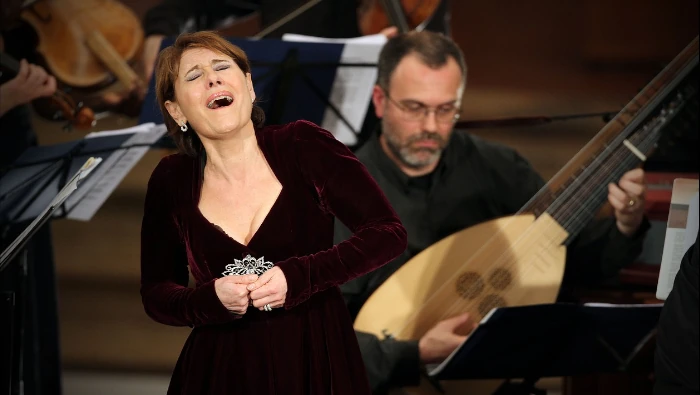Hey there, vocal virtuosos and singing enthusiasts! Are you ready to unlock the secret sauce to stellar singing performances? Today, we’re diving deep into a technique that will set your vocal skills ablaze – the exciting world of vibrato!
If you’ve ever been mesmerized by the rich, shimmering notes of a professional singer, you know what I’m talking about. Vibrato isn’t just a fancy vocal trick; it’s a game-changer in how you connect with your audience, conveying emotions that straight notes simply can’t.
For those of you hungry to level up your singing prowess and truly impress with your vocal power, mastering the vibrato technique is crucial. It’s the cherry on top of your vocal sundae that can make all the difference between a good performance and a goosebump-inducing one.
So, warm up those vocal cords, and let’s get ready to embark on this thrilling journey! Stay glued here, because, by the end of this adventure, you’ll be one step closer to earning your stripes as a vibrato virtuoso! Let the excitement begin!
Understanding Vibrato: What It Is and Why It Matters

Embarking on your vocal journey, one term that often surfaces is “vibrato.” But what exactly is this mystical musical element, and why does it earn such high esteem among singers and listeners alike?
Vibrato is not just any vocal effect; it’s the heartthrob of emotional expression in singing. Imagine the oscillation in pitch that gives voices a rich, quivering quality. That’s vibrato for you—it’s where precision meets passion. The frequency of this pitch variation and its depth carve the unique sonic signature of your vibrato.
Let’s break it down: Picture a note. Now, gently let it sway, slightly up and down in pitch, in a steady rhythm. This pulsation is what adds a compelling depth to your sound. Vibrato is often a hallmark of seasoned singers, but the good news? It’s a learnable skill!
Envision vibrato as the spice that flavors a dish—it can turn a bland note into a savory sensation. It infuses life into melodies and makes performances truly captivating. Without vibrato, singing can sometimes feel flat, even if you’re hitting all the right notes.
So why does it matter so much? It’s simple: emotion. Vibrato connects the dots between technical expertise and expressive artistry. It conveys feelings that words alone cannot. When you master vibrato, you don’t just sing a song; you tell a story that resonates with the very strings of the listener’s heart.
Now that you have a grasp on what vibrato is, are you ready to learn how to weave this exquisite technique into the tapestry of your vocal performances? Stick around, as the next section will guide you through the initial steps to tame this captivating vocal beast. With practice, you’ll find your vibrato adding that magical touch to your singing, enchanting your audience, and showcasing the true depth of your vocal prowess.
Step-by-Step Guide to Learning Vibrato

Embarking on the exhilarating path to mastering the vibrato technique can seem daunting at first, but fear not! Patience and practice are your best companions on this musical adventure. Remember, all remarkable skills take time to develop, and vibrato is no exception. Kickstart your journey with these simple steps and watch your singing transform.
Start Slow and Steady
Begin with the basics. You wouldn’t sprint before you can walk, right? The same principle applies to learning vibrato. Initially, focus on changing pitch at a slow and manageable pace. This foundational practice is essential. Control is the name of the game, and having a solid grip on your vocal tuning is crucial for growth.
Daily Practice is Key
Consistency will be your secret weapon. We live in a world that thrives on instant gratification, craving “everything yesterday.” Yet, the art of vibrato challenges this mindset—it blossoms over time with daily nurturing. Dedicate a portion of your singing practice to vibrato each day. It’s not about overnight success; it’s about building a skill that will last.
Keep it Controlled
As you grow more comfortable, it’s crucial to maintain control. Vibrato isn’t a free-for-all wobble, but a refined modulation of pitch. Your aim is to have a steady, even vibrato that you can bring in and out of your singing as desired. Mastering control allows you to convey emotion through your music effectively.
While at first, it may feel mechanical, with practice, producing a natural vibrato will become as effortless as breathing. Embrace the slow bloom of progress and be prepared to revel in the rewards of your dedication. Keep these tips in tow, and you’re sure to notice your vibrato technique begin to flourish!
Learning from the Masters: Opera and Vibrato

If you truly wish to deepen your knowledge and skill in vibrato, one of the best strategies is to immerse yourself in opera. Opera singers are renowned for their powerful control over vibrato, turning their performances into deeply emotive experiences. By observing and listening to the masters, you can gain invaluable insights into the intricacies of this technique.
Start by exploring a range of opera pieces. Opera can be experienced live if possible, but there are also countless recordings available on platforms like YouTube. As you listen, pay attention to how each singer employs vibrato to convey emotion and add texture to their voice. Notice the variability in speed and depth, understanding that each vibrato is as unique as the singer themselves.
Opera showcases can serve as not just inspiration, but also a form of auditory training for the developing singer. As you expose yourself to various styles and applications of vibrato, you’ll begin to form a mental blueprint of how you might adapt and tailor these techniques to fit your own voice.
Analyzing operatic performances offers more than just an appreciation for vibrato; it enables you to critically listen and perhaps adopt some of the warm-up routines and practices these professionals use. After all, emulating the greats is a time-tested method for growth in any art form.
Remember, while enjoying and learning from opera, keep an open mind. Different genres may use vibrato differently, so exploring a wide variety of singers and styles can broaden your understanding even further. Who knows? You might find an opera singer whose vibrato technique resonates with you on a personal level, and that can be the catalyst in your journey to master this beautiful vocal ornamentation.
Next time you practice, keep the sounds of these opera greats in your ears. Let their mastery guide your own experiments with vibrato, and be patient. With practice and dedication, your vibrato will begin to flow as naturally as the operatic legends who inspire you.
Pre-Vibrato Vocal Exercise: Starting with the Basics

Ready to start feeling the magic of vibrato in your own voice? Fantastic! Before we dive deep into the world of controlled vibrato, it’s crucial to warm up those vocal cords with a preparatory exercise. This simple technique I’m about to share is not only insightful but also quite fun!
First, pick a song. Any song that you feel comfortable with will do, as the melody isn’t the star of this exercise—your emerging vibrato is. The specific note you choose doesn’t matter either; just make sure it’s one you can hold comfortably, because this is about training your voice, not testing its limits.
Now, here’s the playful part: while you’re singing, gently tap on your chest with the fingertips of one hand. Aim for a steady rhythm of about two or three taps per second. Imagine you’re a maestro keeping time for an orchestra—only this time, your voice is the symphony!
Does this tapping bring to mind the soft, intermittent pulse of a weeping doll’s cry? If it does, you’re on the right track. That’s the essence of vibrato – a fluctuation in sound that can transform your voice from a monotone into something truly dynamic and soul-stirring.
But don’t stop there! Keep tapping and singing, and you’ll begin to notice something wonderful: a natural vibrato starting to weave its way into your voice. It might be timid at first, but with each repetition, you’re teaching your vocal muscles a new trick.
Remember, repetition is the secret ingredient to mastery. You might feel a bit silly at first, tapping away at your chest like a drum, but trust me, your diligence will pay off. So tap, sing, and embrace the whimsy of it all. After all, every great vocalist started somewhere, and today, you’re one step closer to adding the vibrant color of vibrato to your vocal palette.
Stay tuned, and keep practicing! Vibrato is a journey, a subtle art that unfolds with time, patience, and plenty of joyful experimentation.
Advanced Vibrato Control Using Diaphragm Muscles

Ready to take your vibrato to the next level? Let’s focus on the powerhouse of your singing voice: the diaphragm. This dome-shaped muscle not only supports your breathing but is also crucial in creating a controlled and beautiful vibrato.
Unlocking the Power of Your Diaphragm
Imagine the diaphragm as the engine behind your vibrato. Just as a car needs a steady and rhythmic pulse to run smoothly, your diaphragm requires a similar pulsation to drive your vibrato. Here’s an exercise to help you develop that control:
Stand or sit comfortably with good posture. Place your hand about four fingers above your navel—that’s where you’ll focus your attention. Now, breathe in deeply and feel how this area expands. As you sing your favorite tune, try to create gentle pulsations here, as if your breath is the wave and your diaphragm the surfer riding it with ease.
Exercise to Fine-Tune Your Vibrato
Begin singing a note that’s comfortable for your vocal range, maintaining a steady pitch. As you hold the note, start to engage your diaphragm by sending quick, rhythmic pulses through these abdominal muscles. Think of it as a heartbeat—consistent but never forced.
At first, this may feel like you’re interrupting your airflow, but with practice, you’ll start to notice a natural and steady vibrato emerging. It’s this balance between control and relaxation that gives your vibrato its signature sound.
Mastering the Subtleties
A captivating vibrato isn’t about dramatic fluctuations—it’s about subtlety and nuance. Practice varying the speed and depth of your vibrato. Remember, the goal is to complement your singing, not overpower it. Your vibrato should ebb and flow just like the dynamics of a song.
Consistent Practice is Key
Initially, you might find this physical awareness a bit challenging. It’s perfectly normal. The intricacies of engaging the diaphragm can be nuanced. But don’t lose heart! Frequent, short practice sessions are more effective than occasional, long ones. Dedication will lead to improvement.
As you develop this skill, you’ll not only gain a greater sense of control over your vibrato, but you’ll also enhance your overall vocal technique. Your tone will grow richer, and you’ll gain more expressiveness in your singing.
Patience Pays Off
Maintain a patient mindset, and remember that every practice session brings you a step closer to vibrato mastery. Embrace the journey and celebrate the small victories along the way.
Continue refining your vibrato, and soon enough, you’ll find your performances imbued with an effortless, captivating undulation that truly resonates with your audience. Keep singing, keep exploring, and never stop learning—your voice has so much potential waiting to be unleashed!
Conclusion: The Vibrato Journey
Let’s wrap it up, vocal virtuosos! Embarking on the path to perfecting vibrato is an adventure filled with ups and downs—much like the pulsating notes you’re aspiring to master. Remember, whether you are just starting or fine-tuning this expressive vocal technique, the key is consistency and a dash of patience.
As you diligently practice the exercises we’ve shared, celebrate each small victory. Your voice is a unique instrument, and learning to wield its power through vibrato will not just enhance your singing—it’ll add a compelling layer of emotion to every note.
Stay persistent, stay inspired, and don’t forget to enjoy every step of this melodious journey. The mesmerizing quiver of a well-executed vibrato can move hearts and stir souls. So, keep at it, and soon, you’ll find your own voice rippling with the kind of vibrato that leaves an audience enthralled.
Keep an eye out for more vocal tips and techniques right here, where we’ll continue to unveil more secrets to amplify your singing prowess. You’re not just learning notes; you’re crafting a siren song that’ll echo well beyond the last measure. Here’s to your success, one vibrato at a time—happy singing!

